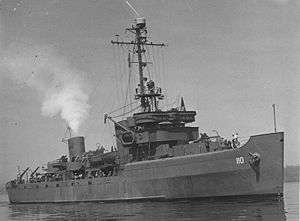Operation Avalanche naval order of battle
Operation Avalanche was the codename for the combined US and British landings on the southwest coast of Italy on 9 September 1943 as part of the Allied effort in the Mediterranean Theater during World War II. The forces landed consisted of the US Fifth Army under Lieutenant General Mark W. Clark. The Fifth Army was made up of the British X Corps, which landed south of the town of Salerno, and the US VI Corps, which landed at the town of Paestum.

The landings were carried out by combined forces of the US Navy and Royal Navy, detailed below.
Naval losses: 2 destroyers, 1 minesweeper, 1 tug, 1 hospital ship
Order of battle

_in_June_1943.jpg)
Task Force 80: Western Naval Task Force
Vice Admiral H. Kent Hewitt, USN[1]
- Embarking

- 1 amphibious force flagship: USS Ancon
- 2 anti-aircraft/fighter director ships: HMS Ulster Queen, HMS Palomares
- 1 submarine: HMS Shakespeare
Task Force 85: Northern Landing Force
Commodore G.N. Oliver, RN
- Embarking

- 2 amphibious force flagships: HMS Hilary, USS Biscayne
- 4 light cruisers: HMS Mauritius, HMS Uganda, HMS Orion, HMS Delhi
- 1 monitor: HMS Roberts
- 18 destroyers: 17 British, 1 Greek
- 7 minesweepers
- 4 tugs (1 sunk by air attack 13 September)
- 13 transports and LSIs
- 90 LSTs: 45 American, 45 British
- 84 LCTs: 24 American, 60 British (5 sunk)
- 96 LCI(L)s: 48 American, 48 British
- 23 subchasers/wooden hull
- 27 minecraft
- 32 Motor Launches
- 13 trawlers
Task Force 81: Southern Landing Force
Rear Adm. John L. Hall, Jr., USN



- Embarking

- TG 81.5 – Fire Support Group (Rear Adm. Lyal A. Davidson)
- 4 light cruisers: USS Philadelphia, USS Savannah, USS Boise, USS Brooklyn
- 1 monitor: HMS Abercrombie
- 4 destroyers (1 sunk by submarine 12 October)
- TG 81.6 – Screen (Capt. Charles Wellborn)
- 12 destroyers (1 sunk by torpedo boat 10 September)
- TG 81.2 – Transport Group (Capt. C.D. Edgar)
- 19 transports: 14 American, 5 British
- 3 LSTs: all British
- 6 scout boats
- TG 81.3 – Landing Craft Group (Capt. F.M. Adams)
- TG 81.7 – Control Group (Cmdr. R.D. Lowther, USNR)
- TG 81.8 – Minesweeper Group (Cmdr. A.H. Richards)
- 9 minesweepers (1 sunk by submarine 25 September)
- 12 motor minesweepers
- TG 81.9 – Salvage Group (Lt. V.C. Kyllberg)
- 2 tugs
- TG 80.2 – Picket Group (Lt. Cmdr. S.M. Barnes)
- 16 PTs
- TG 80.3 – Diversion Group (Capt. C.L. Andrews)
- 1 destroyer: USS Knight
- 7 torpedo boats: 7 British MTBs, 1 American PT
- 4 subchasers/wooden hull
- 6 Motor Launches
- 10 air/sea rescue craft
Task Force 88: Support Carrier Force


Rear Admiral Sir Philip L. Vian, RN
- 1 light carrier: HMS Unicorn
- 4 escort carriers: HMS Battler, HMS Attacker, HMS Hunter, HMS Stalker
- 3 light cruisers: HMS Euryalus, HMS Scylla, HMS Charybdis
- 9 destroyers: 7 British, 2 Polish
Covering Forces
- 2 fleet carriers (Rear Admiral C. Moody, RN)
- HMS Illustrious
- 28 Grumman Martlet fighters
- 10 Supermarine Seafire fighters
- 12 Fairey Barracuda torpedo bombers
- HMS Formidable
- 28 Grumman Martlet fighters
- 5 Supermarine Seafire fighters
- 12 Fairey Albacore torpedo bombers[lower-alpha 1]
- HMS Illustrious
- Force "H" (Vice Admiral Sir A.V. Willis, RN)
- Screen
- 20 destroyers: 16 British, 1 Polish, 2 Dutch, 1 French
- Auxiliaries
- 3 hospital ships: HMHS Newfoundland (sunk by air attack 13 September), HMHS Leinster, HMHS Somersetshire
- 2 fleet carriers (Rear Admiral C. Moody, RN)
Notes
- Biplanes
References
- Morison, pp. 391-394
Sources
- Morison, Samuel Eliot (1954). Sicily – Salerno – Anzio, January 1943–June 1944. History of United States Naval Operations in World War II. IX. Boston: Little, Brown and Co. ISBN 0-7858-1310-1.